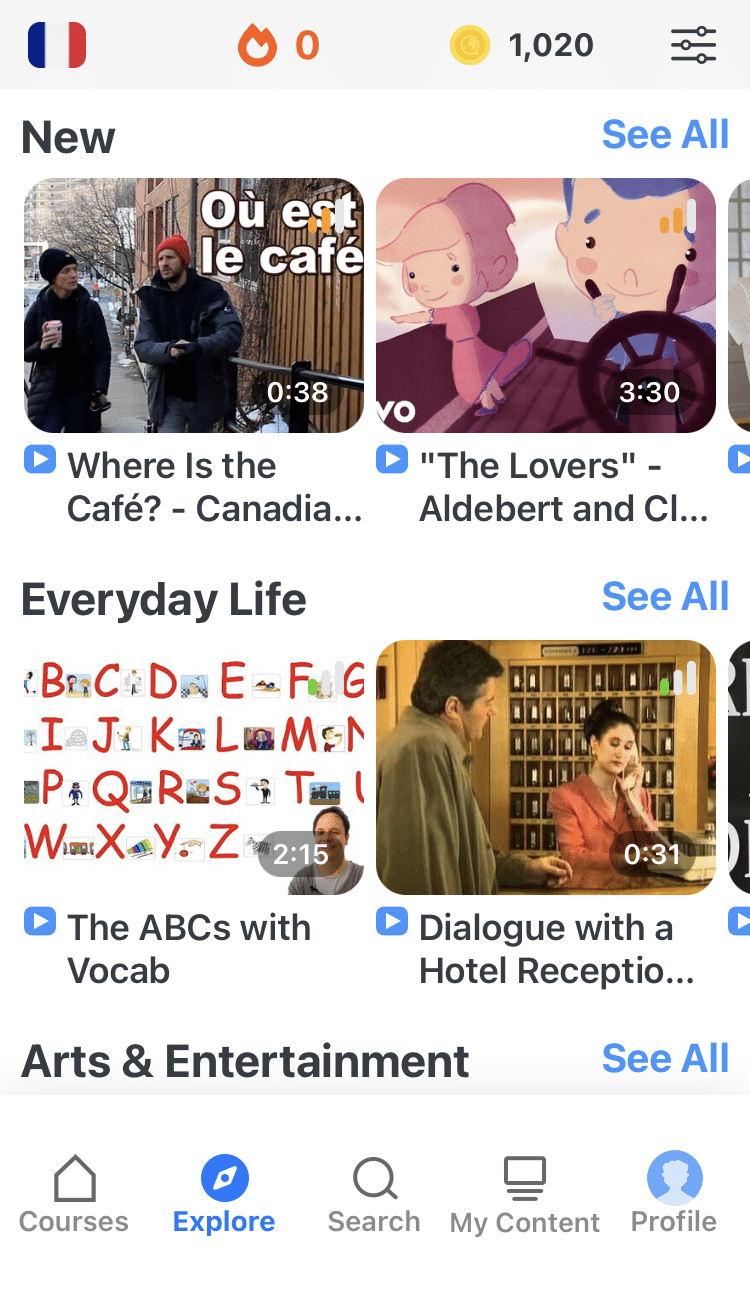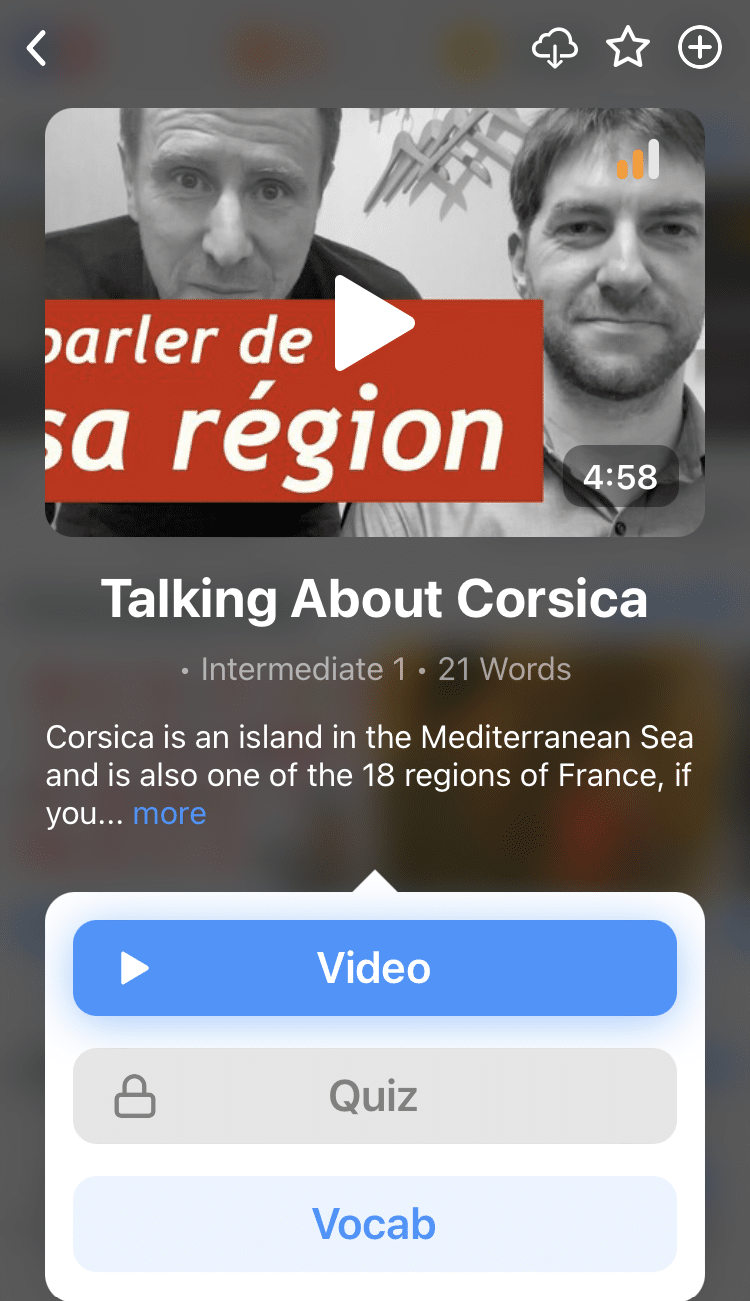
How to Learn French Grammar
Not sure how to learn French grammar without going crazy?
Or just looking for tips to accelerate your French grammar learning?
Today, I’ll present 10 tips I wish I’d heard when I first started learning French grammar.
Had I known them, I wouldn’t have had to wrangle with all of the verb tenses and proper word placements—and don’t even get me started on all those extra letters that come into play once gender and number agreement happens.
I’ll also include some French grammar resources that’ll be helpful right away and way beyond the beginner stages.
Contents
- 1. Learn a Little English
- 2. Get a Rock-solid Handle on Basic French Verb Tenses
- 3. If French Verbs Get Too Tricky, Focus on the Present Tense
- 4. Get Your Pronouns Straight
- 5. Don’t Forget About Gender Agreement
- 6. Use Ne… pas for Negation
- 7. Get a French Dictionary That Includes Grammar Info
- 8. Expose Yourself to Grammar in Real Contexts
- 9. Quiz Yourself Regularly
- 10. Don’t Be Afraid to Explore Non-academic Resources
- And one more thing...
Download: This blog post is available as a convenient and portable PDF that you can take anywhere. Click here to get a copy. (Download)
1. Learn a Little English
I once had a French professor in college who said something along the lines of “You have to have a solid grasp on English grammar in order to learn French grammar.”
Indeed, some basic similarities between French and English are:
- English requires an article before a noun, such as the or a. French is the same way, using le / la / les (the), un / une (a/an) and des (some). One key difference is that French articles are gendered (more on this later).
- Both languages use the same sentence structure—subject-verb-object.
- There are several ways to ask questions in French, but the colloquial form is exactly the same as in casual English—with a voice inflection at the end indicating interrogation.
Of course, if it’s as simple as that, I wouldn’t have to devote an entire article on the subject of how English speakers can learn French grammar!
You’ll find that, as you move up in your studies, French grammar becomes increasingly and dramatically different from its English counterpart. Besides, you don’t want to develop the habit of constantly translating between French and English in your mind—you have to get used to thinking in French to achieve complete fluency.
That being said, mapping out the French you’re studying over the English you already know will definitely help you pick up French faster than if you’re studying the latter in isolation.
You’re probably thinking, “Okay, that’s great and all, but how exactly do I learn French using English?”
Glad you asked, because I have a couple of book recommendations that will make your life infinitely easier:
“English Grammar for Students of French”
Ask around for books that relate French grammar to English, and chances are this one will be the top recommendation. “English Grammar for Students of French” lays out French grammar by comparing it to English grammar, making the task of conquering the former much less daunting.
Every chapter has two parts. First, general grammar concepts are explained in English, preparing readers for the concepts necessary to grasp French. Next, the same grammar point is explained as it relates to French, with examples of those rules being applied. Each chapter explains a different grammar point: a part of speech, a word’s function in a sentence or a grammar term like “tense,” “gender” or “agreement.”
You’ll notice that many French grammatical terms are similar to their English counterparts. For example, a verb is un verbe —not too hard to remember! It’s also worth learning the French names of grammatical terms. This will make reading French grammar books much easier, because they like to be tricky and use French while teaching it to you.
“Side-by-Side French and English Grammar”
If you’re looking for an alternative or complement to “English Grammar for Students of French,” this might be right up your alley. Similar to “English Grammar for Students of French,” this book dives into basic grammatical concepts in English before relating them to their French equivalents.
“Quick Check” exercises are sprinkled throughout the chapters, ensuring that you’re actively absorbing what you’re reading from the book (as opposed to just reading it passively and forgetting everything after the first read-through).
And if you want more grammatical exercises to sink your teeth into, the book has those in spades, too.
2. Get a Rock-solid Handle on Basic French Verb Tenses
As in any language, French verbs are a basic part of every sentence.
Focus on learning basic, irregular verbs and regular verb conjugations, such as the following.
| French Verb | English Translation | Type of Verb |
|---|---|---|
| être | to be | irregular |
| avoir | to have | irregular |
| aller | to go | irregular |
| parler | to talk | regular -er verb |
| finir | to finish | regular -ir verb |
| attendre | to wait | regular -re verb |
Être, avoir and aller, in particular, serve as foundations for conjugating tenses like the passé composé (past tense).
Meanwhile, verbs with the stem -er, -ir, and -re are all recurring verbs in French. That means if you learn the conjugation of one, you’ll learn the conjugation of them all—with some exceptions, of course! This is essential, because many of the French verbs you’ll use are regular and therefore have the exact same conjugation structure.
To master these verbs, I recommend the following resources:
This comprehensive book will answer practically any question you have about French verbs and how to conjugate them. From the present tense to the past tense, future tense and everything in between, it’ll be your go-to resource for figuring out how to use a verb in any possible sentence.
Verbs are arranged in alphabetical order, so you don’t have to know what kind of verb it is to find it in the book. And for new learners, it has English translations to direct you to the exact tense and conjugation you need.
Though the book is called “501 French Verbs,” it goes far beyond just 501 verbs. It actually has an appendix with over 1,250 additional verbs that are conjugated like the 501 already explained.
For French learners, it’s one of the most essential books—and one of the most worthwhile investments.
Verbix is a handy tool that instantly generates all the possible conjugations of every French word in its database.
All you have to do is enter the infinitive form of the French verb you want to conjugate into the box, and presto! You’ll have all of its nominal forms, cognates, tenses, subjunctives, indicatives and more.
I suggest using this tool to check conjugations you’ve made on your own—rather than, ahem, cheating.
3. If French Verbs Get Too Tricky, Focus on the Present Tense
With verbs, it can be overwhelming to learn all the many different tenses. There’s the present, past, past perfect, future, future perfect, past and present participle—and the list goes on.
But when you’re starting out, don’t worry about all these. You can go a long way with the present tense! And once you get comfortable using it to form sentences, as well as having the vocabulary to do so, learning how to put it in the past or future tense won’t be so daunting.
Besides, most compound tenses just involve recycling tenses you already know!
We have a full guide to the present tense in French right here.
4. Get Your Pronouns Straight
Just like English, French uses pronouns to ensure that you don’t sound repetitive when you talk about a noun. For example, instead of saying “John is staying home because John is sick,” you say “John is staying home because he is sick.” Unless it’s not clear from the context who or what you’re talking about, you can usually use pronouns to replace nouns.
French pronouns (and Romance language pronouns in general) work a little differently from their English equivalents, though. For example, the conjugation of the verb être (to be) depends on the pronoun you’re pairing with it—and that’s not accounting for the tense you’re using.
| Conjugations of Être in French | English Translation |
|---|---|
| Je suis | I am |
| Tu es | You are (singular) |
| Il est Elle est | He is She is |
| Nous sommes | We are |
| Vous êtes | You are (plural) |
| Ils sont (masculine) Elles sont (feminine) | They are |
If you’re looking for a more in-depth guide on how to use French pronouns, here you go!
5. Don’t Forget About Gender Agreement
This is arguably one of the trickiest parts of learning French grammar for English speakers. When you name a table, a chair or a house in English, you don’t need to worry about its gender. However, in French, every noun has a grammatical gender.
This is made even more complicated by the fact that the gender of a noun will change the ending of the words referring to it. This concept is known as “agreement.”
For example, any adjective modifying a feminine noun must also be spelled in its feminine form. The article before that noun would also have to be feminine.
Une femme intelligente (An intelligent woman)
Un homme intelligent (An intelligent man)
There are many tricks for learning French noun genders. Here are a few:
Memorize masculine and feminine words in French using lists
For example, the nouns with these endings are typically feminine:
- a vowel then a consonant then “e,” like: -ine, -ise, -alle, -elle, -esse, -ette, -euse, -ance and -ence
- -tion, -sion, -son
- -ure, -ude, -ade
- -ée, -té, -ière
And masculine nouns mostly end with:
- -ste and -tre
- -u, -ou, -oir
- -me, -ment, -isme
- -ble and -cle
- -eau and -eur
- -age and -ege
- Consonants: -b, -c, -d, -f, -k, -l, -m, -n, -p, -r, -s, -t, -x
Remember that there are always exceptions that you’ll have to learn specifically, but this pattern is a useful rule of thumb.
In a similar vein, when learning thematic vocabulary lists, break up words into one list of masculine words and one list of feminine words. For example, when learning foods, you might have le pain (bread) and le fromage (cheese) in one list and la pomme (apple) and la carotte (carrot) in another.
Link words of the same gender and learn them together
Another good way to learn the gender of new words is to learn sentences that suggest the gender to you, such as l‘homme aime son vélo vert (the man loves his green bike) or la femme aime la forêt et ses belles fleurs (the woman loves the forest and its beautiful flowers).
Use mental images to help you recall the gender of words
For example, since bread and cheese are masculine words, you can conjure up an image of dipping bread in cheese fondue. And because apples and carrots are feminine, you might imagine a snack platter with those two. As with the above strategy, this exercise gets you actively thinking about gender and making connections between the words you’re learning.
If you catch yourself wondering if fromage is masculine or feminine later on, you just have to remember which mental image you associated the word with!
6. Use Ne… pas for Negation
Here’s the good news: It’s very easy to create negative sentences in French.
Let’s say you want to turn J’aime le chocolat (I like chocolate) into a negative sentence. All you have to do is put ne before the verb and pas after. In other words, just use the structure ne + [verb] + pas and you’re done! (Important: If your verb starts with a vowel, just use n’ instead of ne.) So, you have:
Je n’aime pas le chocolat. (I don’t like chocolate.)
Here’s another example:
Je parle anglais. (I speak English.) → Je ne parle pas anglais. (I don’t speak English.)
Another cool thing is that you can easily swap “pas” with other words to express different types of negation.
You’ll often hear French speakers use jamais (never) like this:
Je ne parle jamais anglais. (I never speak English.)
You can also express a negative statement using adverbs, adjectives, pronouns and n’importe (no matter, any, whichever). Here’s a more detailed guide on French negation.
7. Get a French Dictionary That Includes Grammar Info
Luckily, there are plenty of French dictionaries that go beyond providing definitions and pronunciations, such as:
- Centre National de Ressources Textuelles et Lexicales (National Center for Textual and Lexical Resources). This is probably one of the biggest names in the French dictionary world. Aside from definitions, you’ll find example sentences taken from authentic texts—complete with citations!
- Dictionnaire de l’Académie française (Dictionary of the French Academy). Another established dictionary is the Dictionnaire de l’Académie française . This one gives you the following information: type of word (noun, adjective, verb, etc.), gender, example sentences, what context the word is used in and more.
- Lexilogos.com. This is basically a directory of links to dictionaries for many languages. For example, the page dedicated to French provides links to online bilingual dictionaries, as well as French-English dictionaries, thesauruses, idioms, slang and more!
Of course, you can always buy a physical French dictionary instead. Look for dictionaries that have a grammar section at the back—if you’re not sure, ask the seller or anyone who already owns a copy of that dictionary. You don’t have to buy a shiny new French dictionary—many secondhand bookstores and charity shops carry used and discounted copies from people who’ve studied French before you.
From these dictionaries, try creating some French sentences, using the vocabulary and grammar guides to help you out. The more you do this, the better you’ll get a handle on both French vocabulary and grammar and the more fluent your French will be.
8. Expose Yourself to Grammar in Real Contexts
It’s not enough to just read and memorize French grammar rules.
To truly learn French grammar, it’s also important that you see and hear a lot of content showcasing authentic examples of the rules you’re learning.
Here are some resources to see or hear French grammar in real contexts:
- French books. Through books, you can see how written French works in authentic contexts. You don’t have to dive into “Les Misérables” off the bat—there are plenty of tomes for French learners of every level.
- French radio. For example, listening to news stations like Franceinfo is a wonderful way to hear French grammar and keep up with what’s going on in France. And if you’re a fan of French music, there are plenty of places to tune in to those, too!
- Podcasts. There are podcasts made for learners like Podcast Français Facile (Easy French Podcast), as well as podcasts for native speakers like Slate.fr. With both of these, you’ll be able to listen to French in context. Plus, you might just find your new favorite shows to follow on your favorite podcast platform!
- French videos. You can start watching French movies and TV shows as well. You could also try a virtual immersion program like FluentU to get you started.
FluentU takes authentic videos—like music videos, movie trailers, news and inspiring talks—and turns them into personalized language learning lessons.
You can try FluentU for free for 2 weeks. Check out the website or download the iOS app or Android app.
P.S. Click here to take advantage of our current sale! (Expires at the end of this month.)
When consuming authentic French content, it’s important to be an active reader/listener. Take notes of any examples of the grammar you’ve previously mastered. For example, if you’ve just studied negative constructions with ne and pas, find examples of that in the material you’re consuming. This will help you know how that piece of French grammar is actually used in real-life situations.
9. Quiz Yourself Regularly
There are loads of places online where you can take tests and quizzes to practice French grammar. You have:
Tex’s French Grammar is a great resource to practice French grammar basics. Originally developed by the University of Texas at Austin to assist students who are learning French, this resource tackles many common grammar topics and is taught by the cute armadillos Tex and Tammy.
This resource is actually a comprehensive online grammar guide, and it includes tutorials on topics such as noun gender, verb tenses, pronouns, prepositions and negation.
Each grammar lesson has a concise explanation of the topic with an example dialogue featuring Tex, Tammy and their friends. There are also fill-in-the-blanks exercises for practice. The “check answers” feature is also available to make sure learners have done the exercises correctly.
Best of all, the lessons can be downloaded into a single PDF for personal use.
Columbia University’s French Language Exercises
Don’t let the fact that it only covers 10 grammatical subjects fool you. This is one of the better resources for testing your French knowledge—and not just because it’s from a prestigious university.
All of the multiple-choice questions are entirely in French. If there’s any word you don’t understand, just click “Vocab.?,” and you’ll be taken to an English translation of the more difficult words and phrases. You can also click “Grammatical Notes” for a quick refresher before you take the quiz.
Most importantly, the quiz gives you instant feedback, complete with explanations as to why your answer is correct or incorrect.
Le FLE pour les curieux (French as a Foreign Language for the Curious)
Le FLE pour les curieux isn’t only a resource for curious French learners. It’s also for serious French students.
The grammar lessons found here can be sorted by DELF level (A1-B1) or by overarching topic. Topics include conjugaison (verb conjugation), grammaire (grammar) and orthographe (spelling). This resource is also all in French and uses more advanced language, so it’s ideal for intermediate learners.
Each lesson focuses on a specific grammar topic, such as talking about a but (goal), cause et conséquence (cause and consequence) and the formation of plural nouns and adjectives.
The lesson explanations are a little longer than previous resources, but they’re easy to follow. The corresponding exercises are multiple-choice and fill-in-the-blanks.
In France, the diplôme national du brevet (National Diploma) is an examination that all students have to take at the end of year nine. Students spend a lot of time studying for it, brushing up on subjects like history, geography, mathematics and, of course, French.
This video, from digiSchool Collège, is entirely in French, and it’s aimed at students studying for the French portion of the diploma. As such, it’s perfect for advanced French learners who want a crash course in higher-end grammar.
The teacher in the video talks about advanced topics in French grammar and conjugation, such as the passé simple (the simple past) and concordance des temps (temporal agreement). On-screen, fill-in-the-blank exercises follow the explanations.
In addition to this one, there are multiple other videos related to studying advanced French grammar for the brevet .
10. Don’t Be Afraid to Explore Non-academic Resources
Studying French grammar doesn’t have to feel like watching paint dry. Plenty of resources online are as entertaining as they are educational—and they’re just a click away!
145 Minutes to Learn French Grammar
This one is a video created by the popular YouTube channel Learn French with Vincent.
In 145 minutes, it covers the most common topics in French grammar, such as numbers, question words and basic verb conjugations. In other words, you can learn French grammar basics in a little less than 2.5 hours!
The exercises included in this video are mostly centered around repeating after Vincent, but this resource is still extremely valuable because Vincent gives helpful pronunciation tips throughout, including notes on liaison (silent letters that become pronounced when preceding a vowel).
Furthermore, Learn French with Vincent has many videos for learning French grammar, as well as a website for you to check out.
This BBC learning resource is packed to the brim with free grammar lessons, vocabulary lists and games to reinforce what you’ve learned. They even have links to popular French radio and TV stations. It’s a great resource to practice what you’ve learned from the resources above.
Courses like Ma France will guide you as you establish a working knowledge of French grammar. The French phrases resource will introduce you to things like French slang and common phrases that you can start incorporating into your conversations.
“Difficultés du français” (Difficulties of French)
I picked up this little book when I was studying in France, and it’s been my ever-reliable companion since.
Organized alphabetically, the book identifies some of the strangest and most confusing aspects of French grammar and uses succinct explanations—with examples—to help you understand them. These “difficulties” range from strange verb conjugations to relative pronoun usage to confusing words and expressions.
The book is written entirely in French, so this is best used after you’ve established a solid foundation of the basics. I’ve found it to be one of the most revealing and eye-opening tools for learning the (often strange) ins and outs of French grammar.
If you’ve been wondering how to learn French grammar, we hope these tips and tricks will make it all easier for you. You’ll soon find that it’s not always easy to learn French grammar, but it doesn’t have to be a pain, either. Just start with the right resources like the ones we’ve recommended above, and you’ll be on your way to glorious grammatical mastery!
Download: This blog post is available as a convenient and portable PDF that you can take anywhere. Click here to get a copy. (Download)
And one more thing...
If you like learning French on your own time and from the comfort of your smart device, then I'd be remiss to not tell you about FluentU.
FluentU has a wide variety of great content, like interviews, documentary excerpts and web series, as you can see here:

FluentU brings native French videos with reach. With interactive captions, you can tap on any word to see an image, definition and useful examples.

For example, if you tap on the word "crois," you'll see this:

Practice and reinforce all the vocabulary you've learned in a given video with learn mode. Swipe left or right to see more examples for the word you’re learning, and play the mini-games found in our dynamic flashcards, like "fill in the blank."

All throughout, FluentU tracks the vocabulary that you’re learning and uses this information to give you a totally personalized experience. It gives you extra practice with difficult words—and reminds you when it’s time to review what you’ve learned.
Start using the FluentU website on your computer or tablet or, better yet, download the FluentU app from the iTunes or Google Play store. Click here to take advantage of our current sale! (Expires at the end of this month.)












